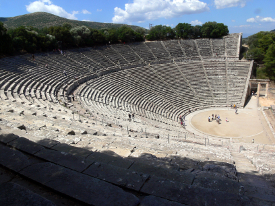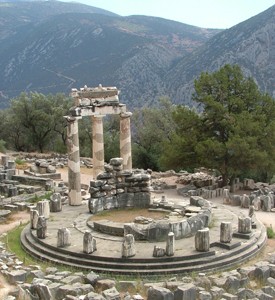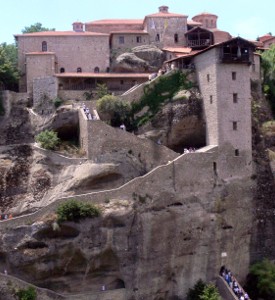
Mycenae, Epidaurus, Olympia and Delphi are famous places of ancient Greece while Meteora was and still is a great religious center and a very important geological phenomenon.
This tour covers the most important ruins of ancient Greece and Byzantine Greece in the Peloponnese and central Greece and gives you the opportunity to see also the Greek country side.
Day 1
You start your Classical Greece Mycenae Olympia Delphi tour early in the morning from the Athens tour terminal or you are picked up from your hotel. Leave by the Coastal Road to the Corinth Canal (shortstop). Drive on and visit Epidaurus which was a small city in ancient Greece, at the Saronic Gulf. Reputed to be the birthplace of Apollo’s son Asclepius, the healer, Epidaurus was known for its sanctuary, the cult of Asclepius at Epidaurus is attested in the 6th century BC.as well as its theatre, which is once again in use today.
The Sanctuary of Asklepios at Epidaurus is a UNESCO world heritage site.
The theatre is marvelled for its exceptional acoustics, which permits almost perfect intelligibility of non-amplified spoken word from the proscenium or scene to all 15,000 spectators, regardless of their seating.
Then proceed to the Town of Nauplion ( shortstop) drive on to Mycenae. and visit the Archaeological Site and the Tomb of Agamemnon. Departure for Olympia Through Central Peloponnese and the Towns of Tripolis and Megalopolis. Dinner and overnight in Olympia, the Cradle of the Olympic Games
Day 2
Olympia was a sanctuary of ancient Greece, known for having been the site of the Olympic Games in classical times, the most famous games in history. The sanctuary, known as the Altis, consists of an unordered arrangement of various buildings. Enclosed within the temenos are the Temple of Hera (or Heraion/Heraeum) and the Temple of Zeus, the Pelopion and the altar area, where the sacrifices were made. The hippodrome and later stadium were also to the east.
To the north of the sanctuary can be found the Prytaneion and the Philippeion, as well as the array of treasuries representing the various city-states.
Olympia is also known for the gigantic ivory and gold statue of Zeus that used to stand there, sculpted by Pheidias, which was named one of the Seven Wonders of the Ancient World by Antipater of Sidon.
Then drive on through the plains of Eliad and Achaia until the magnificent bridge crosses the Corinthian Bay from Rion to Antirion. Pass by the picturesque Towns of Nafpactos (Lepanto) and Itea, and arrive in Delphi. Dinner and overnight.
Day 3
Delphi was the centre of the Ancient World – the “Omphalos” (Navel of Earth) – whose prestige extended far beyond the boundaries of the Hellenic World.
On the slopes of Mount Parnassus, in a landscape of unparalleled beauty and majesty, lie the ruins of the Sanctuary of Apollo Pythios.
Visit the Treasury of the Athenians, the Temple of Apollo and the Museum containing such masterpieces of Ancient Greek sculpture as the bronze Charioteer and the famous athlete Aghias. Depart for Kalambaka, a small town situated at the foot of the astonishing complex of Meteora, gigantic rocks. Dinner and overnight.
Day 4
Meteora is one of the largest and most important complexes of Eastern Orthodox monasteries in Greece, second only to Mount Athos. Among striking scenery, perched on top of huge rocks which seem to be suspended in mid-air, stand ageless Monasteries, where you can see exquisite specimens of Byzantine art. The six monasteries are built on natural sandstone rock pillars, at the northwestern edge of the Plain of Thessaly near the Pineios river and the Pindus Mountains, in central Greece. The Meteora is included on the UNESCO World Heritage List. Return to Athens via Trikala, Lamia, and Thermopylae (visit Leonida’s monument). Arrive in Athens early in the evening.
For prices and bookings please click here